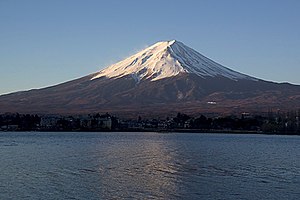Historic eruptions of Mount Fuji
[1] The mountain as it appears now is known as the "New Fuji volcano", which began to erupt about 10,000 years ago.
The peak of Komitake is about 2,300 meters (7,500 ft) above sea-level on the north face of Mount Fuji (at the fifth station).
It created many explosive eruptions that threw out large amounts of scoria, volcanic ash and lava.
Valuable data on the activity of Mount Fuji is recorded in Japanese historical documents dating from the 8th century onwards.
In 864 (the 6th year of the Jōgan era) there was an eruption on the north-east side of Mount Fuji, which produced a great amount of lava.
The earthquake severely damaged the city of Osaka, but more than that, it created enough seismic activity to compress the magma chamber 20 km deep in the inactive Mt.
Scientists study the activity of the magma rising by measuring CO2 emissions in the deeper parts of the volcano.
Fuji would be considered stage I. Magma is at a considerable 10 km (6.2 mi) depth and no emissions of gases can be observed regularly.
Experts have found that the internal pressure of the Mount Fuji magma chamber has increased to an estimated 1.6 megapascals, raising speculation over the possibility of an eruption.

